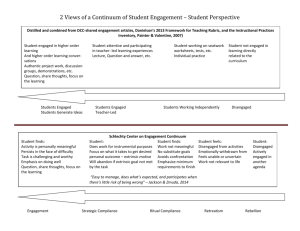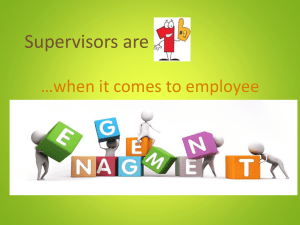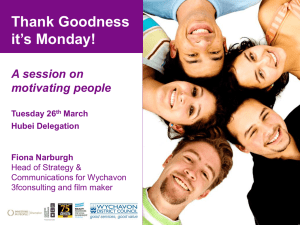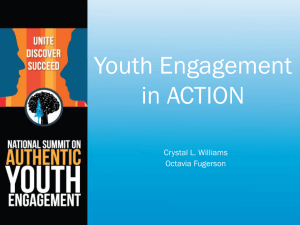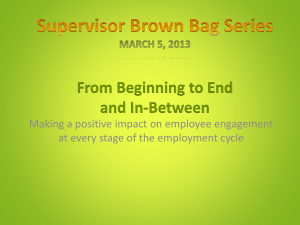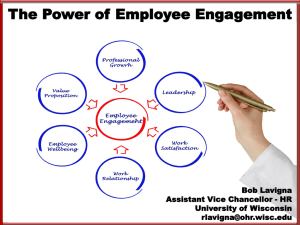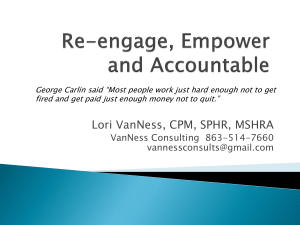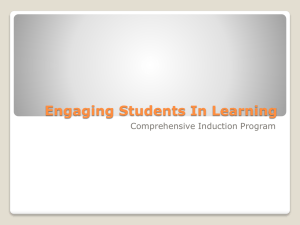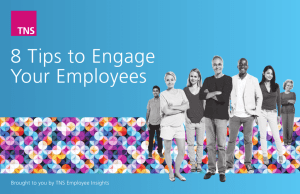Engaged
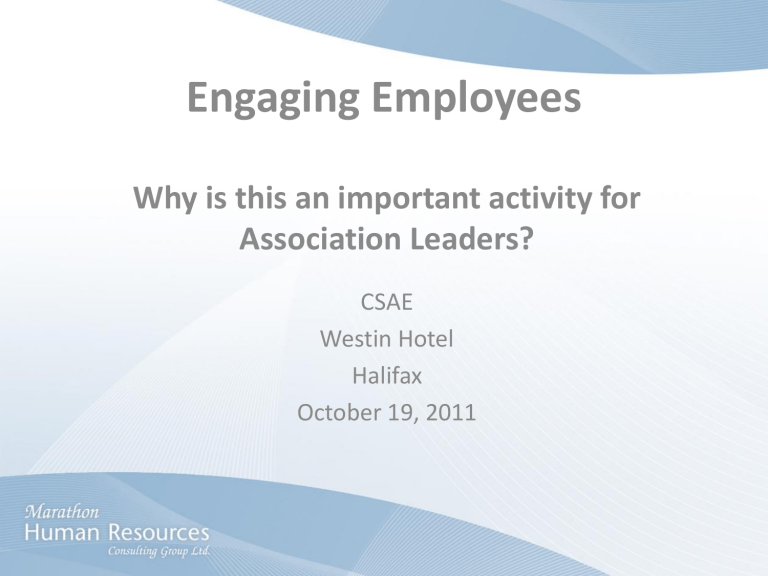
Engaging Employees
Why is this an important activity for
Association Leaders?
CSAE
Westin Hotel
Halifax
October 19, 2011
Defining Engagement
“The extent to which an employee is committed to their work and the organization, and the extent to which this commitment impacts their performance and intent to stay with the organization.”
“The extent to which employees identify with, are motivated by, and are willing to expend energy and extra effort for their employer.”
• ( www.chroda.net
2007)
Defining Engagement
• Based on these definitions, engagement is the sum total of employee behaviour in the organization which can be characterized by:
• Belief in the organisation
• Drive to work and make things better
• Respect and support for others
• Desire to learn new skills
• ( www.chroda.net
2007)
Why Engage?
• 78% of engaged employees would recommend their organizations products or services
• 13% of disengaged employees would do the same
(Gallop)
• 70% of engaged employees indicate that they have a good understanding of how to meet customer needs
• 17% of non-engaged employees say the same (Wright
Management)
Why Engage?
• 67% of engaged employees advocate their company or organization
• 3% of disengaged employees do the same (Gallop)
• 86% of engaged employees say that they very often feel happy at work
• 11% of disengaged employees say the same (Gallop)
• 45% of engaged employees get a great deal of their life happiness from work
• 8% of disengaged employees say the same (Gallop)
Why Engage?
• Greater and more challenging opportunities arise for employees
• Salaries may be better elsewhere!
• Greater mobility of the workforce
• The talent pool is shrinking (Demographics)
• We are all under more pressure to perform
• We have an obligation to be good ‘stewards’
Cause and Effect a continuum of
Inputs and Outputs
INPUT: ENGAGEMENT DRIVERS
•Right employees in the right jobs
•The right leadership
•Organizational systems and strategies
INPUT: WORK ENVIRONMENT
•Aligned effort and strategy
•Empowerment, Teamwork, Collaboration
•Growth and development
•Support and recognition
OUTPUT: ENGAGED EMPLOYEES
•Intend to stay longer
•Deliver enhanced effort
Adapted from: www.chroda.net
OUTPUT: ORGANIZATIONAL SUCCESS
•Satisfied/loyal stakeholders
•Increased employee retention
•Higher output: services, productivity
•Value growth
A Specific Challenge for CSAE Members
Employee Engagement is about
LEADERSHIP
Framing the Challenge
• 90% of leaders say that engagement impacts on their business
• 25% of the same leaders have an engagement plan (ACCOR)
•
What Does A Plan Look Like?
The How
Engaged or Disengaged?
• Take time to assess your team o Most new employees are engaged o What about those who have been around for a long time?
o What about those who have just taken on a new role?
Engaged or Disengaged?
• Employees are normally on a spectrum of engagement:
• Not engaged: indifferent, wait and see, no visible commitment
• Actively disengaged: consistently against virtually everything
• Engaged: builders, eager, focused ‘they want to use their strengths and talents at work’!!
• Adapted from C Coffman 2002
Engagement is commitment based
Rational Commitment:
• Employees believe they will personally benefit financially, developmentally, or professionally from organization. It makes sense for them to stay with the organization.
•
This is Retention
Engagement is commitment based
Emotional Commitment:
• Employees believing in, valuing, or enjoying their day-to-day work, team, manager or organization.
They make the linkage between their role and organizational objectives and values and their own.
They enjoy or find fulfillment in the work.
•
This is Engagement
The How: Step One
• Define the commitment options of your organization
• Rational?
• Emotional?
The How: Step One
• What are the ‘Rational’ drivers of your organization o Pay, incentives o Benefits o Professional Development o Career opportunities o Work-life balance
The How: Step One
• What are the ‘Emotional’ drivers of your organization o Organizational values o Role clarity o Relationships o Purpose o Link between role and strategy
Step One: Example
• A multi-generational workplace (employees & volunteers)
‘Matures’ born 1925-1945 o Now ages 66-86 (15%)
‘Baby Boomers’ born 1946-1964 o Now ages 45-65 (35%)
‘Gen Xers’ born 1965-1979 o Now ages 32-46 (26%)
‘Millennials’ born 1980 – 1994 ish o Now ages 17-31 (24%)
Step One: Example
• Workplace Priorities
(Rational & Emotional Commitments)
• Millennials: Salary; Advancement; Interesting Work, Work-life balance, Good benefits
• Gen Xers: Interesting Work, Work-life balance, Salary, Flexible hours, Intellectually stimulating work
• Boomers: Work-life balance, Good benefits, Work-values compatibility, Fulfilling work, Interesting work
• Matures: Work-values compatibility, Policy and procedure fairness, Fulfillment, Flexible hours, Ability to use abilities/Accomplishment at work o Adapted from Sean Lyons PhD
Step One: Example
• All generations top five motivators: o Work-life balance o Interesting work o A good Salary o Benefits o Flexible work hours o Adapted from Sean Lyons PhD
The How: Step Two
• Understand the commitment drivers of your employees
• Rational?
• Emotional?
• Ask:
• What are your Retention needs?
• What are your Engagement needs?
Step Two: Example
• What the ‘generations’ may say:
• Gen X and Millennials: o I want to jump in NOW! Give me learning, advancement, variety, change, multiple tasks, developmental feedback, fun. Loyalty goes both ways – I expect it from you too!
• Boomers and Matures: o I am here to find meaning and fulfillment; put me where I can contribute.
The How: Step Three
• Define the vision
• Speak the vision!
• Seek alignment o Find the ‘fit’ between ‘commitment needs’ and
‘commitment options’ o Initiate ‘intentional’ relationships
The How: Step Four
• Focus on at least four key components of
‘Intentional’ relationships:
1. Support employees’ sense of personal and career development; acknowledge impact of their contribution at work
2. Demonstrate concern for employee/families health and wellbeing
3. Involve employees in decision making that impacts them
4. Listen to and value the views and contributions of employees
The How: Lead Every Step of the Way
• Employee engagement is directly affected by the quality of leadership
• Leaders have the influence and power to serve as catalysts for higher levels of engagement o Hold people accountable for performance o Recognize a job well done
The How: Lead Every Step of the Way
• Engage your leaders
• More engaged managers have more engaged direct reports
• The direct reports of engaged managers are less likely to leave the organisation
• Higher performing managers have direct reports who are more highly engaged www.chroda.net
The How: Next Steps
• Keep leading
• Express a clear vision of who you are – what your value is – your purpose
• Direct and re-direct to focus on the vision
• Define what it looks like to be engaged in the vision – tell stories or better yet get others to tell their story
• Build relationships
• Acknowledge and attribute success
But: we have no money!!
• Engagement without money
• Start with people already aligned with your vision or purpose
• Clearly define expectations
• Provide feedback – positive and ‘re-aligning’
• Supervisors with relationship skills are essential
• Listening, empathy, problem-solving
But we have no money!!
• Engagement without money
• Recognize successes
• Team recognition
• Peer to peer recognition
• The ‘Red Feather’
• Transparent processes
But we have no money!!
• Some cost effective practices: o Supportive mentoring o Flexible work arrangements o Challenging assignments o Community involvement
Outcomes
• 59% of engaged employees say their job brings out their creativity
• 3% of disengaged employees say this (Gallop)
• 92% of 1500 Managers in the UK that identified an innovative style of leadership in their organizations felt proud to work there
( www.humancapitalleague.com
)
Outcomes
• Employees worldwide who know their
manager ‘as a person’ are more likely to be engaged (Blessing White)
• Higher employee engagement resulted in a
50% reduction in reportable accidents from
18% to 9% over a two year period (Babcock
Marine Clyde)
Outcomes
• More effort put into success: problem-solving, quality
• Reduced absenteeism, turnover
• Employees who consistently speak positively about the organization to co-workers, potential employees and stakeholders
• People want to work with you
Key Messages
• Engagement is seen in a belief that the organization is a good place to contribute skill and effort
• Engagement is demonstrated by behavoiur that is positive
• Engagement is a response to internal and external motivators
• Engagement is a Leadership role
